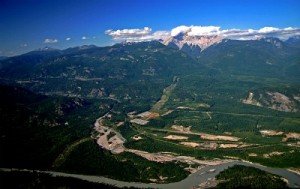By GAGANDEEP GHUMAN
Published: Aug 28, 2016
Published: Aug 28, 2016
DISTRICT of Squamish has embarked on an environmental mapping project, creating a better index of forests, watercourses, wetlands, species and other sensitive eco systems in town.
The new mapping projects updates a previous mapping project that was conducted eight years ago, although in a more comprehensive manner, said Caroline Ashekian, the district environmental coordinator. “It helps us understand where our wetlands are, what type of ecosystems we have, are we surrounded by old growth forests or do we have only one tiny patch of old growth. The idea is to better understand what natural assets are and how we can make more informed decisions,” she said. 

Consultants hired by the district took a map of Squamish and divided it into ‘polygons,’ chunks of land defined by an ecosystem that was minutely studied for two years. In 2015, the consultants studied what information was needed and how some of the old data could be used and finalise the kind of work that needs to be done.
In the second phase that was completed this year, the consultants did the actual mapping, dividing the town into different ecosystems: Old forest, mature forest, woodland, riparian areas, wetland, sparsely vegetated, estuarine, ocean, intertidal and fresh water. Old forests were mapped on 15.2 hectares of the study area, which were typically dominated by an open canopy of large Douglas-fir trees. Mature forests, between 80 and 140 years old, were divided into three subcategories such as conifer dominated, mixed conifer and deciduous and broadleaf.
In similar vein, the study mapped 479 hectares of Woodland and categorized it by age and natural features while riparian areas were mapped for canyons, low, mid and high bench flood plain, and rivers while wetlands were mapped for shallow water, swamp, marsh, and fen.
Next year, the mapping project will continue with researchers mapping fish and other aquatic wildlife and their habits. This watercourse mapping will also include a workshop to improve conservation and management of wetlands and other aquatic ecosystems. Ashekian said there are specific policies in the Official Community Plan that direct council to undertake mapping and update the OCP when new mapping is developed. The sensitive mapping project was this council’s priority but there are no clear guidelines or set policy on the time frame in which the mapping should be updated.
Staff has now recommended that the mapping project gets updated regularly, Ashekian said, which can provide district with a better tool for planning growth in town. The mapping information is also available to citizens and land developers as well as qualified professionals when residential or commercial projects are planned. The mapping project will provide clarity to staff, the community, and to developers and protect more vulnerable and environmentally valuable areas, said Mayor Patricia Heintzman.
“Investing in ESA mapping demonstrates the value that we as a community places on our ecosystems that we are entrusted with, and the biodiversity in our midst. The project is a tangible commitment to protecting sensitive areas, and supports the vernacular of the community that strives to protect our environment,” she said.

